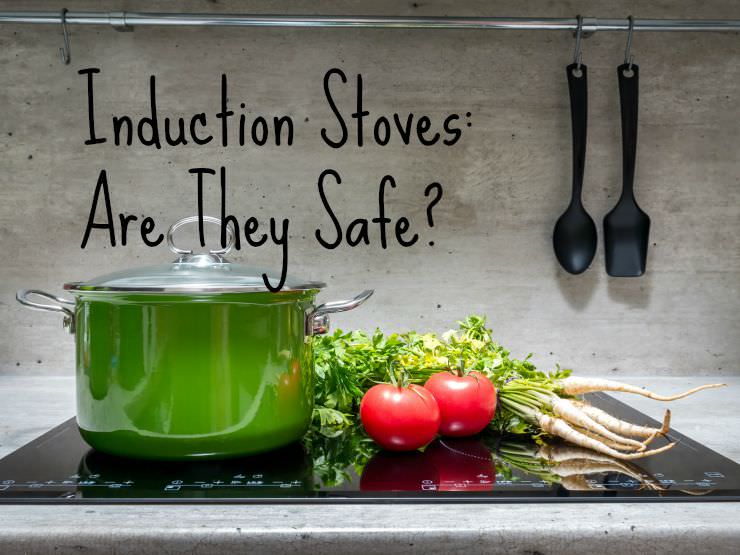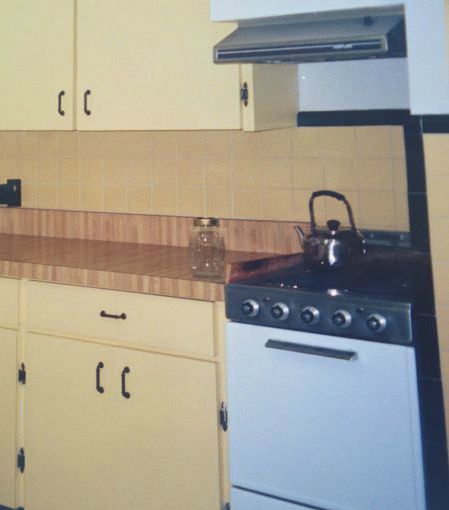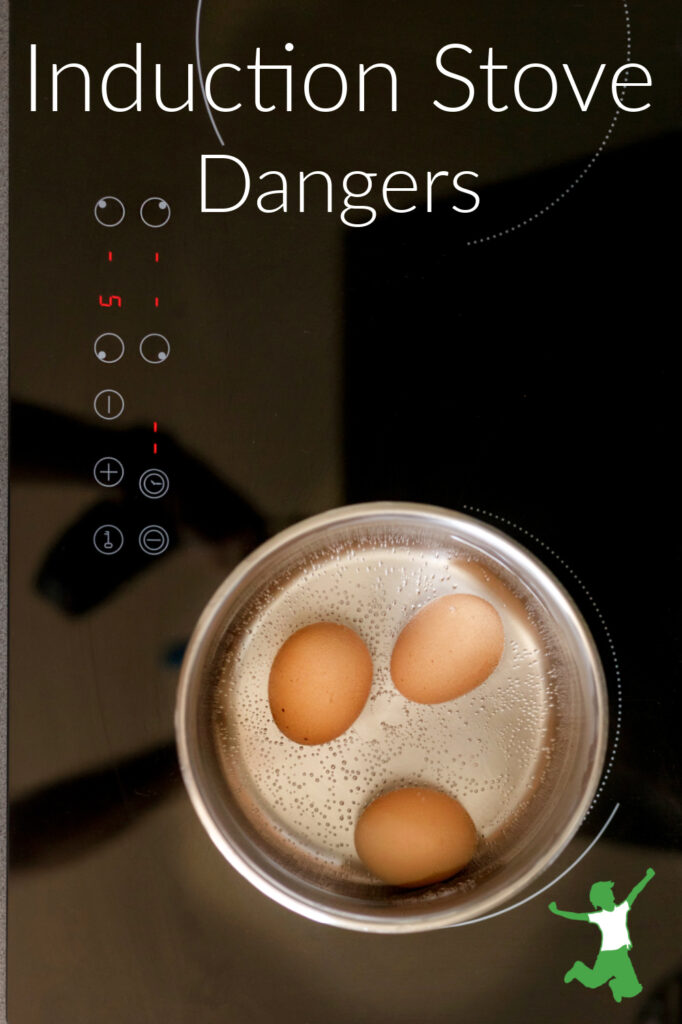The important reasons why bringing an induction stove into your home should be approached with caution as this technology is a source of excessive EMF toxicity as confirmed by scientific study. Even induction stove user manuals warn against standing too close!

Buying a kitchen stove is a rare purchase most people make only a few times in a lifetime. Currently, the trend toward replacing electric cooktops with an induction stove is quite popular. Is this a wise purchase? Let’s take a look …
In our home, we purchased a glass top stove in 1997 when we completely remodeled the (very old) kitchen. At that time, the range we selected boasted the latest and greatest technology which included a glass top cooking surface.
We were upgrading from a tiny 1950’s stove (see hilarious picture below) that while it seemed to fit very well with the orange, 1970s style wallpaper, fake butcher block countertops and canary yellow cabinets (no kidding), it was not something we regretted replacing!
While this new range was awesome (so nice not to have to clean up messes under coil burners anymore!) and has served us well for many years, it recently came time to replace it when problems developed.
Induction, Gas or Electric?
Since we had upgraded to the best technology many years earlier with good results, we thought we should probably do so again. This involved the purchase of an induction stove with all the bells and whistles. The upgrade hopefully would make my many hours spent in the kitchen even more efficient.

Since indoor air-polluting gas stoves were thankfully not an option for our neighborhood, electric was our only choice. We made the rounds to Best Buy, Home Depot, and online to see what was available.
We eventually settled on a stainless steel induction stove. It offered nearly all the latest technology of the (amazing but ridiculously expensive) Viking stoves that celebrity chefs use but with a much more reasonable price tag.
This is the induction stove we originally picked that thankfully, we never bought (we bought this one instead).
I particularly liked the extra-large knobs and oversized glass top that prevented spills from trickling down the crack between the stove and the countertop. It was exactly what I was looking for.
We also decided to get the matching convection oven (that also functions as a toaster) to replace our old microwave oven that I only ever used for storage anyway.
Little Known Dangers of an Induction Stove
Really excited about our upcoming purchase, I posted about it on social media to see if anyone had any further input.
Right away, a couple of comments got my attention.
Jeanette K. said, “My mother’s induction stove was measured by EMF professionals and had extreme readings.”
In addition, Beth H. warned that “The only downfall [with an induction stove] is that you have to use pans that magnets can stick to”.
EMF Risks?
So glad I asked for the input! Neither of these concerns about induction stoves was mentioned by the salespeople I spoke to or the marketing material I had reviewed.
Since I frequently cook with glass, having to only use pans that magnets can stick to would be a serious downside.
It would require purchase of a few pieces of new cookware and bakeware which I really didn’t want or need.
But, it was Jeanette’s comment about the EMF dangers of an induction stove that really gave me pause. EMF overexposure is a huge concern of mine that I’ve written many articles about.
We take great pains in our home to minimize excessive EMF exposure such as turning off wifi at night, using radiation canceling cases and headsets for our cellphones, and EMF shields for our PCs and notebooks.
I also avoid dirty electricity in our home by never using dimmer switches, fluorescent, or LED bulbs.
In addition, we use battery power for our electronics as much as possible. Higher EMF exposure occurs when you use a laptop while it is plugged in, for example.
Induction Technology Emits Strong Magnetic Fields
When I started examining the technology behind an induction stove, I was more than a little shocked and incredibly grateful Jeanette had commented about it to clue me in to do further research. Here’s what I found out:
The technology of an induction stove works by alternating magnetic fields that generate heat in a cooking vessel made of ferrous metals. The benefits of induction cooking as opposed to thermal heating with a traditional stovetop include up to 50% faster and more even cooking of the food and slightly reduced energy usage.
Parents of young children like it because the coil itself underneath the glass stovetop doesn’t actually get hot. This means the cooking surface stays cool and won’t burn little hands or steam up if you spill liquid on it.
While it is extremely controversial whether this type of radiation source is actually dangerous, the data is sufficient enough for me to avoid it.
The latest information I found that should give anyone pause about bringing an induction stove into their home was published by the Journal Bioelectromagnetics in 2012. (1)
The study authors concluded that most induction hobs (rings) exceeded even the high 1998 maximum exposure levels set by the International Commission on Non-Ionizing Radiation Protection (ICNIRP) when a person was standing close to the induction stove.
The worst-case scenario was an up to 16-fold increase from these maximum exposure levels!
Safety Tests
So how in the world did induction stoves ever pass the safety tests?
According to Powerwatch, the safety tests assumed that a person’s body is never closer than 1 foot (30 cm) to the front of the induction stove. Standing that far away would be considered “normal usage”.
I don’t know about you, but I don’t cook standing at least a foot away from my stove. My arms definitely aren’t long enough!
In fact, this would be pretty much impossible if you needed to reach the back burners.
Don’t Use a Microwave? You Won’t Want Induction Either
The bottom line is that if you avoid microwaved food and microwaves in general, you will want to pass on the induction stove as it uses similar technology.
I’ve not used a microwave in 25 years (and not missed it for a second, I might add). Why would I start now exposing myself and my family to potentially dangerous, concentrated sources of EMFs with an induction stove which works in a similar fashion?
Of course, induction stove manufacturers insist the technology is safe.
They claim that the radiation hazard dissipates within a few inches to a foot of the appliance. “Normal usage” would not expose a person to a radiation hazard.
Right?
I’ll pass thanks.
Safer Alternatives
Fortunately, the exact same stove I wanted was available in a traditional, thermally based cooktop without an induction feature. This is the case with all the induction ranges I examined in fact!
This is the stainless steel electric stove model we eventually bought. We’ve had it for several years now and continue to love it! As a bonus, it much more easily fit within our budget than the unsafe induction models!
Sometimes the latest and greatest isn’t always the best or even the safest.

References
(1) Exposure of the human body to professional and domestic induction cooktops compared to the basic restrictions
(2) Powerwatch: In Your Home. EMF Cooking Safety
(3) Induction stove user manual
More Information
Are Pressure Cookers Safe (and do they form MSG in food?)
Clay Pots for Safe Cooking
10 Tips for Using Stainless Steel Cookware Safely
Fitbit Health Concerns (particularly while you sleep!)
Are AMR Devices Safer than Smart Meters?
Heavy Metal Toxicity Raises Risk of EMF Sensitivity
Reducing Exposure to Dirty Electricity
The Health Hazards of Wireless Baby Monitors
Harvard MD Speaks Out about the Health Dangers of Smart Meters
Protect Yourself from a Smart Meter








We just had a new Samsung induction stove delivered this week. We were excited by the sales pitch and it being better than gas. The first time we turned it on to test it (with the largest burner) my wife’s iPhone 6 was about 18 inches from the stove. The screen started to visibly scramble and she has since lost her touch capability. The stove did very real damage to the phone, so we already have contacted the store and are returning the induction and going back to regular electric. We’re convinced the stove’s magnetic field is too strong or not contained to simply the cooktop. This has me concerned about electronics near the stove, but also what else it could be affecting. And the second thing the sales person didn’t tell us was the terrible humming and buzzing noise the stove can make with non cast iron cookware. It simply not a nice cooking experience.
Hi all. Just thought I’d add my two cents worth. I’ve performed over 3000 radiation certifications with the Narda SRM-3006 meter – the standard field meter used by all professionals for this type of measurement. I haven’t done cooktops though – I don’t have the right probes which are $10k each.
What I’ve learnt from my work: the pan on an induction cooktop will be re-radiating the RF energy – it acts as an antenna itself albeit an inefficient one that loses energy as heat. Because the pan becomes an antenna DON’T use steel implements with it. The steel implement will extend the antenna to your hand which should be avoided.
Standard precautions around these sort of radiators would be not to have kids or pregnant women near them, where the developing cells, might be placed in high fields.
The pan will be safest when full of organic material which will absorb stray fields. Cooking a stew will result in far less radiation transmission to the user compared with melting a knob of butter.
These devices have somehow dodged certification. Laptops and phones all need to be certified prior to use, normally published as SAR compliance. Most of the world use the ICNIRP standard. USA use a looser standard which is not as up to date but still OK.
Sooner or later these cooktops will need to be certified correctly and then the radiation zones will be published, proper guidelines for working around RF fields described, and then users can be made aware of the risks. The risks are low according to the latest long term ICNIRP study results, it’s just the manufacturers are making your risk choices for you!
Oops, sorry. I forgot the link. m.youtube.com/watch?v=COeSLQgt-c4
I was looking for info on induction stoves and read your post. As many have mentioned in the comments, it’s not just induction stoves that are risky – electric smooth top ranges are big EMF dispensers as well. Here is a link to a video testing a regular smooth-top electric stove. The EMF readings are off the charts. I think it’s the same as the stove you bought. The tester recommends that gas stoves are the only safe option. Of course, you need to use them with a proper range hood – those weak ones attached to over-the-stove microwaves probably won’t do the job. Maybe a rocket stove, used outside, is the way to go. 😉 Bummer for sure.
Note that it is infrared radiation (aka, HEAT) that comes from an electric stove. These are not comparable to the unnatural waves used to heat food coming from an induction stove.
I tried to not use the microwave, but after a few weeks brought it back to the breakfast room.
I use it minimally, because some things just can’t be warmed in an oven or on stovetop and still be good.
I do not cook with it like years ago some households did.
Induction Ovens should be properly called RF(Radio Frequency) Induction Ovens. They work by the principle that when a Ferro-magnetic material is placed in the vicinity of the RF field it is producing the resultant high “Eddy currents” circulating around the material (in this case your cookware) will cause instant heating. The danger in my opinion, is that whatever residual Rf field the cookware is not intercepting is what is left for you to absorb if you get close enough to this field. This is similar to the risk of cancer you could have living near a Radio or TV transmision tower.
And also, saying microwave oven is dangerous and not healthy are plain wrong too. It’s a myth! Not back with true facts. Try google it, something about the myth of microwave oven is not healthy. There are latest articles mentioning about this myth. If this is a myth, now one should ponder to consider the induction cooker capabilities too.
I’m sorry, but the truth of the matter is that there is very little evidence supporting the theory that IH cooking is harmful to your health. Citing one study that concludes the exposure levels are above the recommended limit is not enough to conclude that there is any danger present.
Furthermore, I think you understood the distance that one would need to be from the unit itself. It’s not literally one foot away from the front of the stove, but from the actual internal device that is causing the heating. Unless you’re lying on top of the stove, you aren’t going to absorb any radiation, period.
Then why does the user manual stay to stand at least one foot away from an induction stove when it is operating?
I actually checked the manual and it did not say this at all. It said if you have a pacemaker or other heart regulator you needed to stand back 30 cm. Of course, this makes sense since magnets affect pacemakers, just like how those with pacemakers can’t sleep on magnetic mattresses. Big difference. However, I still want to learn the truth about these cookers.
The manufacturers do not admit or warn about EMFs because they are not required to by regulation.
Hi Sarah, thanks for this enlightening article. I’m so disappointed and upset. I’ve been working hard over the years to ‘detox’ our lives and home – and while we are surrounded by toxins which would be impossible to eliminate altogether, I finally feel as though we’re in a good place, until now of course. I’ve been using an induction cooker for a few years now (used it throughout my pregnancy) and I love it, it’s completely replaced the need for a microwave since it heats up so fast, but at a cost apparently! Here I was happy that I have been microwave-free for years only to find out I’ve been using something just as bad! Anyway, it’s never too late. I live in Europe and we call things differently over here, just to confirm, ceramic cooktops are safe, right? Cause we don’t have gas in our apartment so my only other option would be to get a ceramic cooktop.
The cooktop needs to get hot when you turn on the burners … this assures it is not induction.
Have you done any research on EMFs emitted by glass cooktops? We are in the middle of a kitchen renovations and I’ve recently discovered that glass and induction cooktops both have higher than recommended EMF. Like you, I really don’t like gas cooktops.